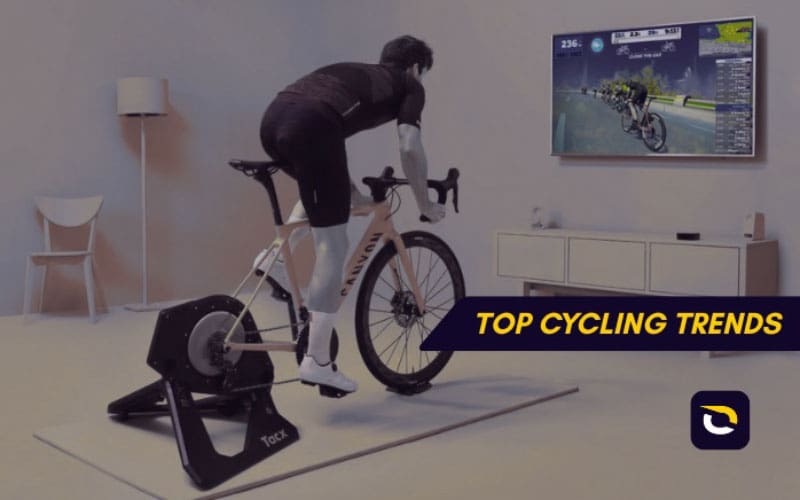From cycling tech 2025 innovations to smart trainers, cycling wearables, and the best cycling apps, technology is transforming the way we ride indoors and outdoors. Discover the best cycling gadgets, the latest bike computers, and how the ROUVY indoor cycling app and other virtual cycling tech are redefining performance, training, and the rider experience.
Cycling has undergone significant changes over the past decade. Electronic gears are now standard on some mid-range bikes, smart trainers are not reserved for the elites, and AI is helping to plan our programs and analyze our data to further improve.
In this article, we’re going to be speaking about the advancement of technology and the impact it has had on cycling, and what direction we are looking to go forward. Let’s talk cycling tech 2025!
1. From analog to AI: How tech is transforming cycling
Although this might sound scary, it’s welcomed. We’re becoming faster, stronger cyclists who can even stay safer thanks to cycling technology trends, and it’s only going to get more exciting with the rumors we’re hearing from the big brands.
2. The growing role of virtual training and smart platforms
One of the biggest advancements has been indoor training. We went from basic wheel-on turbo trainers, which shook the house, to full-blown smart trainers, which were silky smooth and changed resistance automatically.
Not only that, we have virtual worlds to explore – but on platforms like the ROUVY indoor cycling app, we can go and explore the real world without having to leave our own home, and it’s only getting better.
Smart trainers and indoor setups: What’s new
Although we might think we’re at maximum capacity and the technology has a ceiling, it definitely hasn’t. Turbo trainers are getting much quieter and, with real-life simulation modes, make us feel like we’re riding on gravel or actually going up hills.
It’s not just the experience we’re getting from these trainers, but the way we store them. We are seeing many more apartment-friendly models that can reduce vibration and be stored away in a small cupboard.
Let’s not forget full-blown smart bikes. Many brands, such as Tacx and Wahoo, continue releasing improved versions of smart bikes that don’t require you to have to use your own bikes. You’re able to simply jump on and get riding with others.
ERG mode, automatic resistance and ROUVY integration
What a lot of people don’t understand about indoor training is just how immersive it is with smart trainers. With applications like ROUVY, you get automatic resistance. This is where, when coming to a hill on the route, the resistance starts to engage. The best cycling apps have this technology.
We then have ERG mode too, which means you can plan a workout to power – for example, intervals – and the trainer will adjust automatically to give the correct resistance. It’s an incredible feature, and as a rider, it lets you switch off.
ROUVY is one of the best cycling apps, and integration is another great feature, which means you can connect a trainer, heart rate monitor, speed sensor, and much more, bringing all the stats to enhance your workout.
Compact setups for small apartments
There’s a misunderstanding that indoor cycling gear has to be bulky and take up a lot of space. Well, it doesn’t. With great turbo trainers such as the Elite Direto, which can fold away, they no longer need to take up all the space in the house. They continually get smaller the more advanced we get.
1. Bike computers and real-time metrics
Bike computers have come a long way, and it’s interesting to see modern-day technology against classic technology. Do you remember those classic bike computers that necessitated a wire running down the fork to a sensor on the front wheel?
Best GPS units and power-tracking devices
We now have accurate GPS devices from industry leaders such as Garmin and Wahoo. These not only give us data on how far we’ve gone but also heart rate, elevation, gearing information, and even double as navigation systems.
The latest bike computers have the ability to connect to applications like ROUVY, Strava, and even TrainingPeaks. It’s easy to upload your data to examine it and give further advice and instruction on when to train again, and how hard you actually worked in the session.
2. Wearables: Smarter than ever
Cycling wearables are becoming more and more popular, not just for athletes and amateurs but also day-to-day riders. Devices such as Fitbits and Garmin watches are ever so popular and tell us a lot about who we are and what our bodies are doing. The best cycling gadgets are not just Garmins.
Heart-rate monitors, smartwatches and muscle oxygen sensors
The most common cycling wearables are watches, but you also have strap-on heart-rate monitors, smart rings, and much more. Typically, these tell us data such as heart rate, sleep activity, and even some are muscle oxygen sensors.
What pros use (and what actually helps amateurs)
Pros use quite similar tools to what we amateurs often use. We have chest-strap heart-rate monitors, cycling computers, but where they differ is often glucose monitors, moxy monitors, and hydration monitors. The best cycling gadgets are typically readily available to us all.
3. Virtual Riding Revolution: Apps Like ROUVY Leading the Way
Applications such as the ROUVY indoor cycling app are storming upfront with pro-designed online training plans, cycling workouts for a wide variety of fitness levels, and thousands of real-life cycling routes filmed on location around the world. No longer are we cycling in a virtual world, but we’re virtually cycling the real world on the sport’s most iconic climbs.
AI training plans, structured workouts and performance feedback
Not only do we get improved experiences when training with the use of AI, but we also get recommendations on what training to do next, and it gives us a much more in-depth look into what is happening with our bodies.
Augmented reality and immersive cycling
The route a lot of companies are now going down is augmented reality and immersive indoor cycling gear. Taking it to the next level and making indoors feel a little more like outdoors.
Where virtual meets real: AR overlays, gamification and terrain simulation
We have seen some interesting cycling technology trends coming into the market soon. Some riders are using headsets. We have game controllers that strap to the handlebars for cornering and terrain simulation for different online terrains.
1. Sustainable tech and eco-friendly innovations
The future starts here, and when we see companies make an effort to bring not just new technology but sustainable technology, this goes a long way. Let’s explore what companies are doing when it comes to cycling technology trends and virtual cycling tech.
Solar-powered gear, recycled materials, carbon-neutral trainers
Not only are many companies, such as Garmin, using solar technology to self-power gear and reduce cycling charges, but we have them using sustainable materials and making a big effort to reduce the amount of packaging and make it recyclable.
New brands making sustainability a priority
It’s good to understand the lengths companies are going, and we feel a lot of this has been driven by new companies coming in and making a difference. For example, Elite is using recycled plastic in trainers. Cycling technology trends often focus a lot on sustainability.
2. Upgrades that actually improve performance
Decades ago, technology came in and performance improved greatly, but in modern times, it’s really down to marginal gains more than anything else. These days we’ve seen such innovations as adaptive tire pressure, meaning you can change it on the go, and even AI shifting patterns through gearing.
3. Data-driven insights: What’s worth your money
Data will always be worth the money when it comes to professional cycling. Knowing what’s going on in the body and getting real-time data on glucose, hydration, and much more goes a very long way to improving performance. In modern times, body monitoring is the key. Indoor cycling gear is changing.
4. The difference between trend and transformation
It’s important to understand the difference between trend and transformation. A good example: Carbon wheels are a transformation, and oval chainrings are a trend. Some have stuck around, and we still use them every day. Others have slowly been driven away without seeing results.
5. The future of cycling tech: What’s coming next
When we get asked here at ROUVY HQ what the future of cycling and virtual cycling tech is, most of the team feels the advancements are not going to be as expected. We feel the advancements will come in training, such as smart trainers, cycling wearables, and AI.
AI coaches, real-time biometrics, adaptive resistance
AI coaches will be a part of the future and will be able to break down data much better and faster than others. We will see much more biometrics and real-time data technology, and this could work in turn with turbo trainers and smart bikes for the perfect training.
Predictions for 2026 and beyond
2026 isn’t far away, and already we hear rumours about how companies are moving forward and what directions they are taking. Whatever 2026 brings, we feel AI will be a huge part of it.
The latest bike computers will have a lot more technology and understand us better than ever before.
No products found.



















